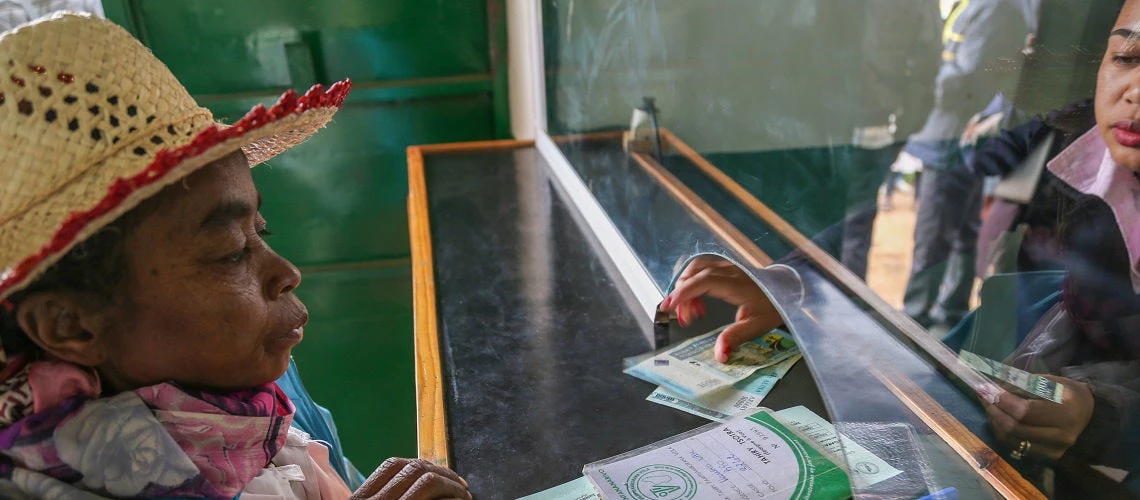 Woman receiving a cash transfer in the town of Betafo, Madagascar
Woman receiving a cash transfer in the town of Betafo, Madagascar
While the world is still in the midst of dealing with the health and socio-economic impacts of the COVID-19 (coronavirus) shock, one key lesson is already emerging: Social protection is proving its potential as an emergency instrument to protect affected households. Countries with strong social protection systems, underpinned by inclusive personal identification systems, comprehensive social registries with household information and robust digital payment systems, have been able to ramp up support to their impacted populations faster and more effectively.
"As parts of the world start to anticipate life beyond this crisis, a key question for policymakers will be: How can countries “build back better” and make sure their social protection systems can respond quickly and efficiently to future shocks?"
As parts of the world start to anticipate life beyond this crisis, a key question for policymakers will be: How can countries “build back better” and make sure their social protection systems can respond quickly and efficiently to future shocks? This could make a significant difference for populations vulnerable to shocks, like that provoked by this pandemic, as well as to the impacts of climate change.
Social protection can help people adapt to climate change:
Social protection already helps households, communities and economies cope with shocks, making them ideal instruments to help them adapt to climate change. The response to the COVID-19 shock shows how “adaptive” social protection can expand on a temporary basis in response to a shock by expanding to a larger pool of beneficiaries or by providing larger benefits (or both). Shock-prone countries across world have been experimenting with similar approaches to respond to climate shocks. The emerging experience is encouraging: for example, in Fiji, households covered by the Poverty Benefit Scheme have recovered more quickly thanks to exceptional transfers introduced after tropical cyclone Winston. Cash transfers in Niger helped build the resilience of households to climate change through diversifying income sources, encouraging savings and preventing poor coping decisions when shocks hit.
Cash transfer programs have also increasingly been reinforced with “accompanying measures” focused on economic inclusion, human capital formation and climate adaptation. These could include behavior change interventions focused on helping people deal varying weather conditions and diversifying crops, savings interventions to generate a buffer to absorb climate shocks and enable investments in adaptation as well as skills training and coaching to support diversification of livelihoods. These can encourage long-term adaptation actions that reduce households’ vulnerability to climate change. Emerging experience from Ethiopia and the Sahel region in Africa suggest significant impacts of such interventions on households’ climate resilience. A focus on early childhood development, nutrition and health interventions can also help raise household and community capability to protect human capital.
And it can help countries mitigate against climate change:
Over the long term, there is no substitute to decarbonizing the world economy in order to stabilize global temperatures. Experience from Indonesia illustrates how cash transfers can promote both adaptation and mitigation by raising households’ incomes, so they are better able to deal with sudden shocks, but also helping them abandon livelihoods such as logging, which contribute to climate change. Climate-sensitive public works programs can also promote cost-effective reforestation and irrigation or combat soil erosion, and countries like Mexico and China have cash transfer programs that explicitly encourage beneficiaries to engage in ecological conservation practices.
Employment programs can also help workers move from carbon-intensive occupations to greener occupations. For example, programs to manage the social and labor impacts from coal mine or gas field closures are critical to facilitate closures and to ensure a “just transition for all”. And experience ranging from Armenia and Ukraine to Ghana shows how social safety nets can help facilitate the politically challenging reforms of energy subsidies by protecting the poor from energy price increases.
How can countries “build back better”?
What will it take to more fully realize the potential of social protection to help communities be better protected from shocks? There are three parts to the answer:
First, enhance social safety nets by expanding coverage of social protection programs and strengthening delivery systems to make programs scalable and climate shock-responsive: This entails developing unique and universal identification of individuals, with appropriate oversight and accountability; social registries of poor and vulnerable households; and digital payment mechanisms to swiftly transfer cash to affected households.
Second, coordinate on preparedness: Countries can strengthen early warning systems that help predict droughts and floods, with automatic triggers or pre-arranged solutions to initiate swift cash transfers to affected people. For example, the Kenya Hunger Safety Net program can provide exceptional transfers in anticipation of droughts and floods thanks to strong existing delivery mechanisms and pre-positioned financing.
And third, learn from what we are living through: Leveraging social safety nets in response to the COVID-19 shock now will create new “muscle memory”, including delivery mechanisms to help reach affected communities quickly. Making these more robust and learning from this experience will help communities respond to the next shock they face, including that of climate change.
There is no vaccine coming for climate change. But by focusing on the social protection that vulnerable communities and people need – whether supporting them to deal with the impacts they are already facing today or helping reduce carbon emissions to put a break on global warming - governments can help their citizens be better prepared for any shocks that come.



Join the Conversation